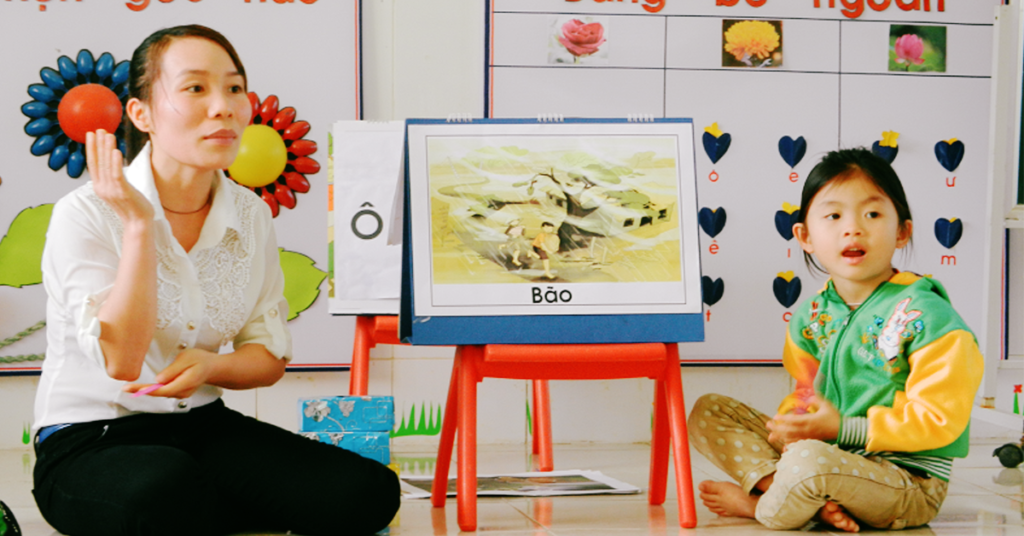4 min read
From sweltering summers and harsher winters to tangible air pollution and people struggling to catch a breath of fresh air: fighting climate change is a global effort. Vietnam is among the top five countries at the receiving end of climate changes’ catastrophic impact. According to the World Bank (2019), “almost 60 percent of Vietnam’s total land area and over 70 percent of its population were at risk to these natural hazards”.
Countries have committed to taking urgent action to combat climate change and its impact as set out in Sustainable Development Goal 13. And yet, millions of children around the world are sporadically denied continued education as schools are forced to close while communities and governments deal with natural disasters as a result of climate change.
In these unpredictable times, what is the role of teachers? Are empowered teachers, whose autonomy is fully unleashed to continue providing quality education to the most vulnerable, the ‘innovation‘ we need?
Monsoons, typhoons, flooding and mudslides: teaching in Vietnam is anything but smooth sailing
Vietnam is no stranger to school closures. As one of the countries that is particularly vulnerable to the devastating effects of climate change, Vietnam’s education institutions frequently shut their gates. Those communities who feel the effects of climate change most severely are the rural communities that live downstream of polluted areas, in coastal regions that are prone to flooding and typhoons, and in mountainous regions where natural resources are degrading. Each year seems to get worse, with this monsoon season opening with the most powerful typhoon Vietnam has seen in over 20 years, Noru, causing power outages, mudslides and evacuations.
As a result of these natural disasters triggered by global warming, schools are forced to close for varying lengths of time to respond to climate events and their aftermath. This includes repairing infrastructure caused by a violent storm, securing clean water supply after a flood, or ensuring that learners can walk a safe path to school. While schools and communities take the necessary steps to safeguard their communities following a climate disaster, schools remain closed – and learners out of school.
With limited resources available, education is not always prioritised when shelter needs to be rebuilt and safe drinking water is miles away, but neither can it be put on hold. Yet tailoring responses to each climate disaster and school closure is not feasible for governments long term and depending on non-government organizations is not a sustainable solution either. So where does this leave the children who at risk of unfinished learning?
Unleashing teacher autonomy
Developing learner autonomy has been described as the ultimate goal to achieve in education (Benson, 2011). As B. Kuramavadivelu, a professor of Applied Linguistics and specialist of teaching methods, elaborates, “autonomous individuals are those who are willing and able to think independently and act responsibly” (2003). Autonomy has the potential to ensure learning continues away from the classroom, however, it is in the classroom that autonomy is primarily developed. But teachers can only promote autonomy in their learners if they themselves know what it is to be an autonomous learner (Little, 1995). Teacher autonomy is referred to as a high degree of self-awareness and the ability to assess one’s own strengths and weaknesses, engage in reflection to be able to learn from experience and see failures as opportunities for growth and learning (Powell and Powell 2010). That is why throughout the years, VVOB has put teacher competences and autonomy front and centre in its programmes.
It is time to unleash teacher autonomy to apply their professional competency and contextual knowledge when crisis strikes. For teachers are the best placed to understand and meet the educational needs of their learners when climate disruptions interrupt the regular school pattern. However, to empower teachers to use their autonomy, governments need to let go of power. The Covid19 pandemic undeniably stalled and regressed gains made in education, but it also broke the ice for a shift in power dynamics as Ministries of Education were ‘compelled to give schools and teachers more leeway than usual to embrace school autonomy’ (Seghers, M. 2021), with positive results.
The first steps have been taken. Educators have demonstrated their commitment to their calling and their resilience to buffer the learning loss school closures cause. Could now be the time to refocus our efforts away from ‘new’ innovations and added layers of complexity, and instead put our trust back in teachers to use their agency to ensure quality education for all?


















